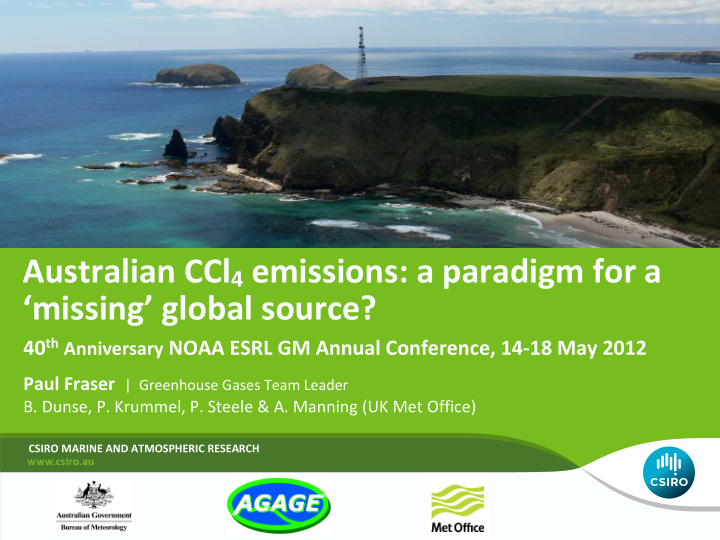



Australian CCl 4 emissions: a paradigm for a ‘missing’ global source? 40 th NOAA ESRL GM Annual Conference, 14 ‐ 18 May 2012 Anniversary Paul Fraser | Greenhouse Gases Team Leader B. Dunse, P. Krummel, P. Steele & A. Manning (UK Met Office) CSIRO MARINE AND ATMOSPHERIC RESEARCH
Global CCl 4 : NOAA, AGAGE & Antarctic firn WMO scenarios consistently over ‐ predict rate of decline Unaccounted ‐ for sources? Australian CCl4 emissions | Paul Fraser
Global CCl 4 emissions: AGAGE & NOAA pre ‐ 1990: 130 k tonnes/yr post ‐ 1995: 80 to 60 k tonnes/yr early ‐ 1990s rapid decline: developed world CFC phase ‐ out Australian CCl4 emissions | Paul Fraser
Global CCl 4 emissions: ‘bottom ‐ up’ v ‘top ‐ down’ potential emissions = production – 98% * feedstock – 75% * destruction = 40 k tonnes AGAGE – potential emissions ‘gap’ (2005 ‐ 2008) Australian CCl4 emissions | Paul Fraser
Australian CCl 4 emissions: Cape Grim CCl 4 pollution episodes Cape Grim CCl 4 pollution episodes maximum 1 ‐ 2 ppt correlate with other urban emission species: CO, HFC ‐ 134a air mass trajectories show these episodes come from Melbourne Australian CCl4 emissions | Paul Fraser
Australian CCl 4 emissions from Cape Grim data ISC : interspecies correlation, CO reference species (Dunse et al ., 2005) NAME inversion: Lagrangian particle dispersion model (Manning et al ., 2011) Australian emissions constant at 160 tonnes/yr (2000 ‐ 2010) Australian CCl 4 production ceased early 1980s, imports ceased late 1980s consumption ( emissions) since the 1990s UNEP data: Australia has zero CCl 4 Australian CCl4 emissions | Paul Fraser
Aspendale CCl 4 pollution episodes CCl 4 pollution episodes maximum 4 ‐ 5 ppt where does the CCl 4 come from? Australian CCl4 emissions | Paul Fraser
Aspendale CCl 4 & HFC ‐ 134a pollution ‘roses’ HFC ‐ 134a: NE of Aspendale (demographic centre of Melbourne) CCl 4 : NW of Aspendale: industrial complex west of Melbourne CBD Australian CCl4 emissions | Paul Fraser
Melbourne: potential CCl 4 emission sites EPA identified CCl 4 soil contaminated sites EPA licensed soil treatment and toxic waste treatment sites CCl 4 emissions confirmed at Lyndhurst toxic waste site by up ‐ wind/down wind sampling (2011: 10 ppt difference 1 tonne/yr) currently testing Brooklyn site Australian CCl4 emissions | Paul Fraser
Australian halocarbon emissions: global fraction Species Fraction HFCs 1 ‐ 3 % HCFCs, CFCs 0.5 ‐ 1 % CH 3 CCl 3 1 ‐ 2 % CCl 4 (from landfills) assume 1 ‐ 2% based on atmospheric data and National GHG Inventory reporting Australian landfill emissions 160 tonnes global landfill emissions 8 ‐ 16 k tonnes landfills 20% ‐ 40% of global 40 k tonnes ‘gap’ between emissions and UNEP potential emissions Australian CCl4 emissions | Paul Fraser
Water chlorination: CCl 4 source? CHCl 3 > CH 3 Cl > CH 2 Cl 2 , CCl 4 :: 1000:100:<1 What is the significance of this CCl 4 source? source 0.1% of the CHCl 3 CCl 4 source OCl ‐ + Cl ‐ + 2H + Cl 2 + H 2 O basic acidic Cl 2 + organics CHCl 3 +……CCl 4 ? Australian CCl4 emissions | Paul Fraser
Water chlorination: CCl 4 source? Australian CCl4 emissions | Paul Fraser
Conclusions Cape Grim data suggest that Australian CCl 4 emissions are about 160 tonnes/yr – based on UNEP data, Australian CCl 4 emissions should be zero Aspendale CCl 4 data suggest that these emissions possibly originate from contaminated soils and toxic waste treatment plants Global CCl 4 emissions from contaminated soils/toxic waste treatment could be 50 ‐ 100 times the Australian emissions (as are many other chemical emissions) Global emissions from this source could be 8 ‐ 16 k tonnes/yr, 20 ‐ 40% of the ‘gap’ between ‘top ‐ down’ and ‘bottom ‐ up’ emission identified in WMO 2010 Water chlorination (potable, waste, pools) may be a source of CCl 4 How large? – pool flux chamber experiment pending Australian CCl4 emissions | Paul Fraser
Thank you CSIRO Marine and Atmospheric Research Paul Fraser GHG Team Leader t +61 3 9239 4613 e paul.fraser@csiro.au w www.csiro.au MARINE AND ATMOSPHERIC RESEARCH
Equivalent effective stratospheric chlorine CCl 4 : chemical feedstock (CFCs), solvent, refrigerant, fire extinguishers AGAGE global data ( = 60), not lagged dominated by CFCs: 45% (2011); CCl 4 : 11% (2011) 1960: CFCs ‐ 9%; CCl 4 ‐ 16% Australian CCl4 emissions | Paul Fraser
Australian CCl4 emissions | Paul Fraser
Recommend
More recommend